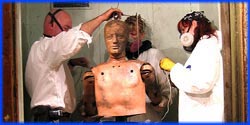


Premier Date: April 20, 2011
busted
Adam and Jamie found a lake similar to the one shown in the video and laid a strip of turf to its edge in order to ensure good traction. Wearing the same type of water-repellent shoes, they each made several runs but wound up in the water each time. They brought in Olympic sprinter Wallace Spearmon, thinking that increased speed would help, but he also failed.
After studying film footage of the so-called “Jesus Christ lizard” (Basiliscus basiliscus) running on water, Adam and Jamie decided to build separate footwear rigs to duplicate its leg movements. They called in Jessica Fortunato, a trained acrobat and gymnast, and had her try both rigs: Adam’s with hinged foot platforms and a long tail, and Jamie’s with concave foot cups and an outrigger frame held in front. She was unable to stay above water, whether unaided or using either of the rigs.
At this point, Adam and Jamie declared the myth busted and built a submersible bridge to replicate the results. After camouflaging it and setting up the camera at a particular angle, both were able to run across the surface until they went off the end of the bridge.
For the following myths, the Build Team investigated the ability of everyday objects to reduce the likelihood of injury or death from an explosion. To identify at what distances from an explosion the shock wave would cause injury and death, they began by detonating a 3-pound (1.4 kg) charge of C-4 with rupture disks at various distances set to burst at 13 psi (90 kPa) (injury) and 75 psi (517 kPa) (instant death). Distances of 10 and 20 ft (3.0 and 6.1 m) were found to be the thresholds of the death and injury zones, respectively.
For each of the following tests, one object was placed 10 feet (3.0 m) from the explosion and another was placed on the other side of the explosion, 20 feet (6.1 m) away. Rupture disks were placed behind each object along with a foam-cutout figure to gauge shrapnel injuries.
confirmed
The tables were placed on their side, facing the blast, and the disks and foam figures were set behind them. Both figures were broken in the blast. The 10 ft (3.0 m) table was destroyed, but the disks did not burst. At 20 ft (6.1 m), the table was heavily damaged and the “injury” disk did not burst but it did deform noticeably. The team noted that shrapnel from the splintered table might cause injury or death independently of the shock wave.
confirmed
The cars were placed to present one side toward the blast, with the disks and figures behind the front end. No injury was noted at 20 feet, while only the “injury” disk burst at 10 feet.
confirmed
The disks and figures were placed inside the dumpsters. The team observed the same results as for the car and noted that the side toward the blast showed some deformation.
confirmed
Since the team only had enough time and materials to build one wall, they moved the blast site as needed to achieve the 10- and 20-foot distances. The 20-foot test was performed first; the wall stood, and the disk deformed but did not burst. After the wall was repaired, the 10-foot blast collapsed it and crushed the figure. However, both disks remained intact.
Previous: Episode 161: Blue Ice